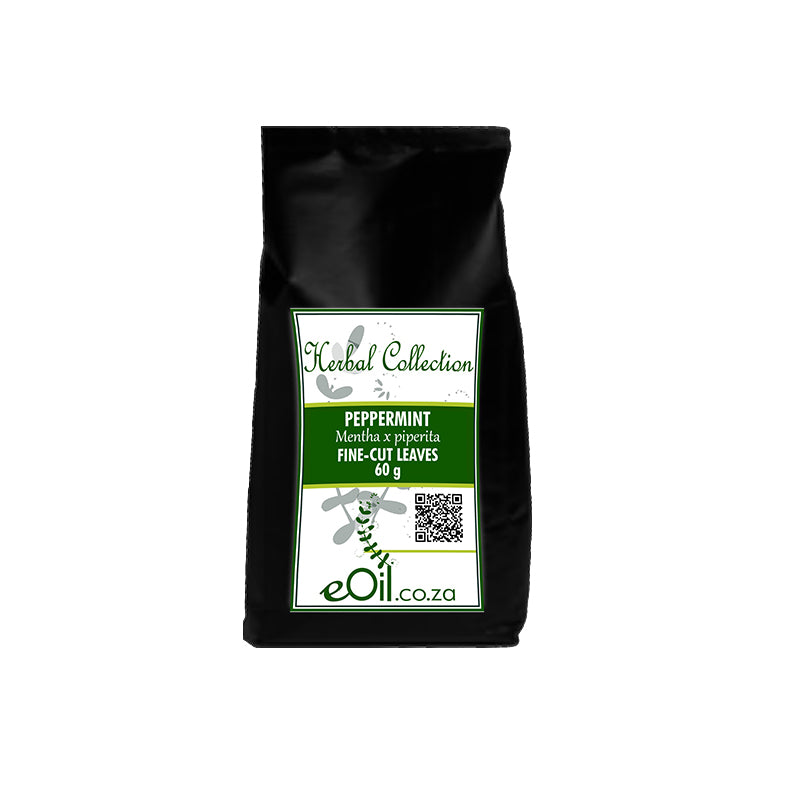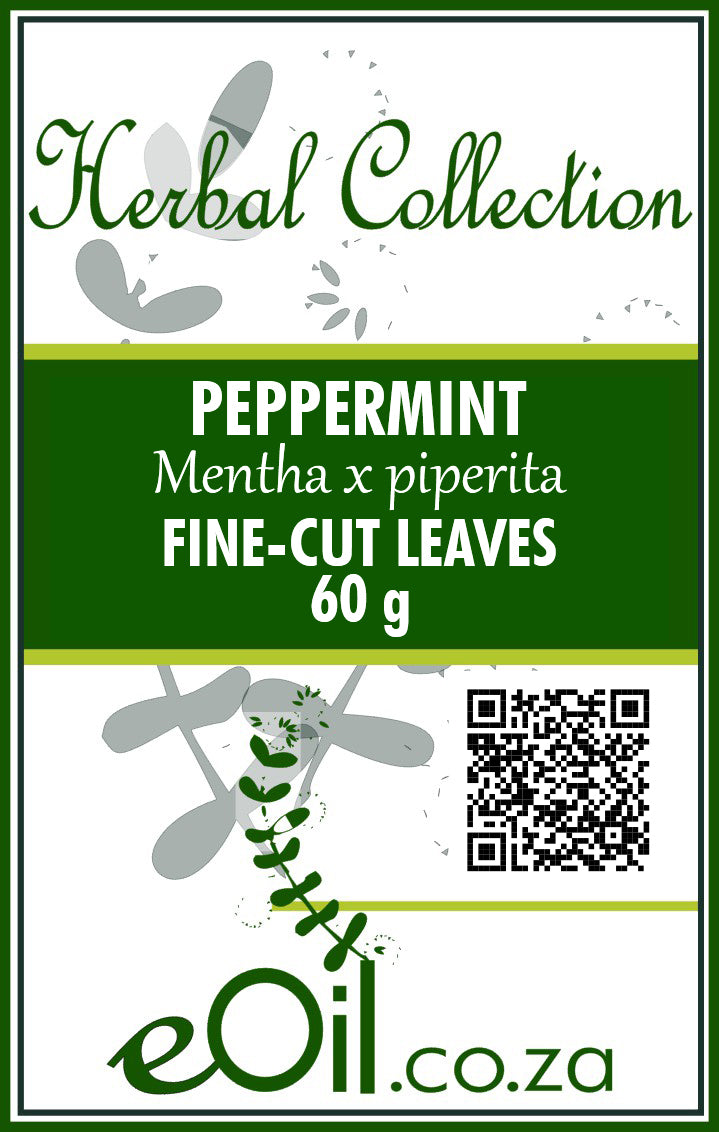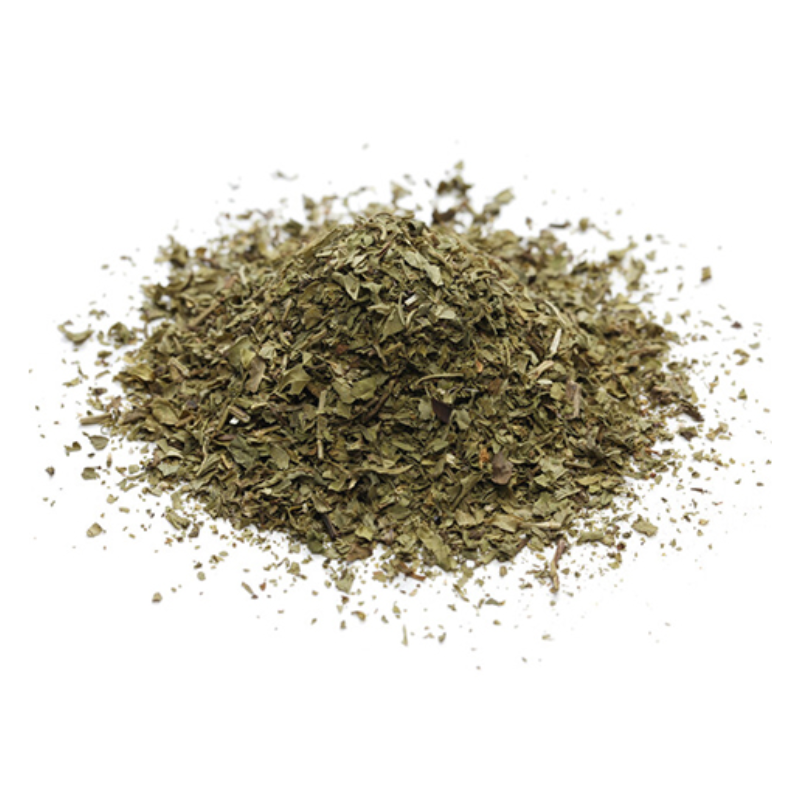Peppermint Leaves Dried Fine Cut Organic - Herbal Collection
Peppermint Leaves Dried Fine Cut Organic - Herbal Collection - 60 g is backordered and will ship as soon as it is back in stock.
Description
Description
Peppermint Leaves Dried Fine Cut Organic - 60 g - Herbal Collection
Mentha piperata
TRADITIONALLY USED FOR
Identification
- INCI Name: Mentha Piperita Leaf
- Country of Origin: Primarily cultivated in the United States, particularly Oregon and Washington, as well as in Europe and Morocco.
- Extraction Method: Leaves are harvested and dried naturally or mechanically.
- Part Used: Leaves
- Common Names: Peppermint, Mentha piperita
- Appearance: Dried leaves are typically dark green and crumbly.
- Odour Notes: Strong, fresh, minty aroma with a cool undertone.
- Active Ingredients: Contains volatile oils such as menthol (7-48%), menthone (20-46%), menthyl acetate (3-10%), and menthofuran (1-17%).
- Approximate Shelf Life: 1-2 years when stored properly.
Storage Conditions: Store in a cool, dry place away from direct sunlight and moisture to maintain potency.
Instructions for Use
- Herbal Tea: Infuse dried leaves in hot water for a refreshing and soothing tea.
- Culinary Use: Use as a flavoring in dishes, desserts, and beverages.
- Aromatic Use: Add to potpourri or sachets for a fresh scent in rooms and closets.
Reported Benefits and Properties
- Digestive Aid: Helps alleviate symptoms of indigestion, gas, and bloating.
- Respiratory Support: Provides relief from symptoms of the common cold and congestion.
- Antimicrobial Properties: Exhibits mild antimicrobial effects, which can help in maintaining oral health.
- Cooling and Soothing: The menthol content provides a cooling sensation, useful in soothing skin irritations and headaches.
Traditional Uses
- Aromatherapy: Used to invigorate and refresh the mind, and to alleviate stress and tension.
- Natural Cosmetics: Incorporated in skincare products for its cooling and anti-irritant properties.
- Natural Perfumery: Used for its fresh and minty aroma in perfumes and scented products.
INFORMATION
Source : http://www.wikiphyto.org/wiki/peppermint
Reference on http://www.wikiphyto.org
Translation in English by Google Translate (go to the page of the source linked | on Chrome cellphones go on the 3 dots on the top right and select translate in your preferred language | on laptop right click your mouse and select option translate when hoovering on the page
plant name
Peppermint, peppermint (English)
International Latin denomination
Mentha x piperita L. (Mentha piperita)
botanical family
Lamiaceae
Description and habitat
- Perennial plant by its rhizome, very aromatic, with square section stems, dark opposite leaves, 80 cm high, with a very characteristic smell of menthol when crushed. They are covered with large hairs secreting essential oil .
- Cultivated in Europe, Asia, North America
History and tradition
- Dried mint leaves have been found in pyramids from the 1st millennium BC
- Prized by the Greeks and Romans
- Peppermint is actually a hybrid of Water Mint ( Mentha aquatica ) and Spearmint or Sweet Mint Mentha spicata L. = Mentha viridis (L.) L.
Parts used
- Aerial parts
- leaf essential oil
Dosage forms available
- Whole plant tincture
- leaf essential oil
- Menthes available in TM :
- Mentha arvensis tincture whole plant
- Mentha piperita tincture whole plant
- Mentha pulegium tincture whole plant
- Mentha rotundifolia tincture whole plant
- Mentha silvestris tincture whole plant
- Mentha viridis tincture whole plant
Usual dosages
Composition
Main components of the plant
- Essential oil (1 to 3% = peppermint oil) with menthol (35 to 55%), menthone (10 to 40%), menthyl acetate , isomenthone , neomenthol , pulegone , piperitone
- Flavonoids : luteolin , menthoside , eriocitrine , luteolin-7-O-rutinoside , diosmin , hesperidin , narirutin , isorhoifoline
- Phenolic acids : rosmarinic acid and caffeic acid , quinic acid , 5-O-caffeoylquinic acid (or chlorogenic acid )
- Phenols
- Triterpènes
- Carotenoids
Main components of buds or young shoots
Main components of essential oil
- Menthol (35-55%), isomenthol
- Menthone (10-40%), isomenthone , pulegone , piperitone
- Menthyl acetate , neomenthol, 1,8-cineole (4-14%), alpha-pinene , beta-pinene
Mentha spicata
- carvone 40-80 %, acétate de dihydrocuminyle, limonène, dihydrocarvone
Mentha x villosa contains:
- piperitone oxide 55%
Properties
Plant properties
- Muscle relaxant, relaxant and antispasmodic of intestinal smooth muscles by blocking the calcium channel [1] and probably parasympatholytic effect [2]
- Analgesic by the aqueous extract [3] and anesthetic effect on the central and peripheral nervous system [4]
- Neuroprotective, antidepressant effect by MAOI effect and affinity with GABA-A, inhibition of acetylcholinesterase ( Mentha x piperita and Mentha aquatica ) [5]
- Stimulates digestive secretions, but inhibits biliary emptying [6] , facilitates gas expulsion, diaphoretic
- Anti-ulcer [7]
- Antiseptic
- Antiviral [8]
- Anti-oxidant and anti-radical by eriocitrin [9] , [10]
- Antitumor [11] , protective against benzopyrene-induced carcinogenesis and mutagenesis [12]
- Anti-histaminique, antiallergénique
- Immunomodulateur
- Potential chemoprevention and radiation protection agent [13]
- Prolonged consumption of mint may decrease testosterone levels and increase FSH and LH in male rats, with diffuse germ cell aplasia in the seminiferous tubules [14]
- The essential oil is analgesic and anti-migraine
- Peppermint EO is repellent and larvicidal against Aedes aegypti , the agent of dengue [15]
- Piperitone oxide from Mentha x villosa is potent antihypertensive
Bud properties
Properties of essential oil
- General stimulant and nerve tonic, slightly exciting
- Antiseptic, antifungal [16] , activity on Trichosporon ovoides , agent of scalp mycosis, with Cymbopogon winterianus , Cinnamomum zeylanicum , Melaleuca alternifolia , Eucalyptus globulus [17] , anti - Helicobacter pylori [18] , anti-herpetic on HSV -1 and HSV-2 even resistant to acyclovir [19]
- Can help reduce antibiotic resistance by acting on the detection of the quorum of bacteria or "quorum sensing" (see menthol )
- Immunostimulating effect, increases innate immunity and humoral response [20]
- Secretolytic, nasal decongestant, astringent
- Skin numbing and refreshing
- Nasal vasoconstrictive, may be irritant, antispasmodic (relieves morphine-induced sphincter of Oddi spasm)
- Anti-migraine essential oil [21] (positive experiment with 10% alcohol at 90° in local applications to the temples)
- Sympatholytic for Lapraz & Duraffourd [22]
- 2 grams of peppermint essential oil leads to the abolition of reflexes and bulbar paralysis
- Inhalation of essential oil is anti-emetic, but less than that of spearmint [23]
- Hairy mint EO Mentha x villosa is hypotensive by endothelial activity [24]
Indications
Indications of the whole plant (phytotherapy)
- Nausea, gastroesophageal reflux, aerogastria, motion sickness
- Colopathies, spastic colitis, digestive spasms, bloating, irritable bowel syndrome
- Urolithiasis
- Migraines : application locale de l'HE
- Allergic rhinitis [25]
- Female hirsutism (?) Prolonged consumption of mint may decrease testosterone levels
Indications of the bud (gemmotherapy)
Specific indications of essential oil (aromatherapy)
- Essential oil to be reserved for adults, few indications for children
- Enters into synergy with the majority of other essential oils in infectiology, potential interest in bacterial resistance [26]
- Spasmodic colitis, digestive spasms, irritable bowel syndrome [27] , [28] , [29] , [30] , [31] , in the form of enteric capsules with colonic release [32]
- Aerogastria, hiccups (short-term treatment), the use of essential oil by inhalation in postoperative nausea requires additional studies for the Cochrane review [33]
- Inhalation of lavender and peppermint essential oils may improve sleep quality in cancer patients (randomised study) [34]
- Urolithiasis
- Migraines: intranasal administration of peppermint essential oil diluted to 1.5% reduces the intensity and duration of headaches (randomized double-blind trial versus placebo) [35]
- Local application of peppermint EO on the forehead, earlobes, temples and neck, repeated every 5 minutes would result in a total improvement in 95% of cases
Known or suspected mode of action
- Weak parasympatholytic (?)
- Menthol and mint essential oil possess considerable antiplasmidal activity in Escherichia coli [26]
Usual formulations
- Peppermint leaves: 20 grams for 1/2 liter of simmering water, infuse 10 minutes. Drink during the day
Regulations
- French Pharmacopoeia list A (leaf, flowering top)
- Activity recognized by the German Commission E
- ISO NF T 75-210 standard ( peppermint essential oil )
- Peppermint essential oil is considered safe for ingestion by the FDA (Food and Drug Administration)
- It is classified as GRAS (Generally Regarded As Safe) and FA (FDA‑Approved Food Additive).
Possible side effects and precautions for use
- HE neurotoxic at high doses for children (be careful, not before 30 months, rather respect 5 to 6 years)
- It can cause bronchial spasm in young children
- Prohibited in pregnant women and children
- 2 grams of peppermint essential oil leads to the abolition of reflexes and bulbar paralysis
- May cause headache, bradycardia, tremor, ataxia, insomnia
- Possible allergies to menthol
- Caution in case of gastroesophageal reflux, gallstones or hepato-pancreatic disorder
Bibliographic references
- Go↑ Alam MS, Roy PK, Miah AR, Mollick SH, Khan MR, Mahmud MC, Khatun S. Efficacy of Peppermint oil in diarrhea predominant IBS - a double blind randomized placebo - controlled study. Mymensingh Med J. 2013 Jan;22(1):27-30. PMID 23416804
- Go↑ Moutinho, Carla & Matos, Carla & Neves, José & Teixeira, Dora & Cunha, Sílvia & Gomes, Ligia. (2013). Antispasmodic activity of aqueous extracts from Mentha x piperita native from Trás-osMontes region (Portugal). International Journal of Indigenous Medicinal Plants. 29. 1167.
- Go↑ Yousef A. Taher. Antinociceptive activity of Mentha piperita leaf aqueous extract in mice. Libyan J Med. 2012; 7: 10.3402/ljm.v7i0.16205. Published online 2012 March 27. doi: 10.3402/ljm.v7i0.16205 PMCID: PMC3316159 texte intégral
- Go↑ Atta AH, Alkofahi A. Anti-nociceptive and anti-inflammatory effects of some Jordanian medicinal plant extracts. J Ethnopharmacol. 1998 Mar;60(2):117-24. PMID 9582001
- Go↑ López V, Martín S, Gómez-Serranillos MP, Carretero ME, Jäger AK, Calvo MI. Neuroprotective and neurochemical properties of mint extracts. Phytother Res. 2010 Jun;24(6):869-74. PMID 19943334
- Go↑ Goerg, K. J., & Spilker, T. (2003). Effect of peppermint oil and caraway oil on gastrointestinal motility in healthy volunteers: a pharmacodynamic study using simultaneous determination of gastric and gall-bladder emptying and orocaecal transit time. Alimentary pharmacology & therapeutics, 17(3), 445–451. https://doi.org/10.1046/j.1365-2036.2003.01421.x PMID 12562459
- Go↑ Khayyal MT, el-Ghazaly MA, Kenawy SA, Seif-el-Nasr M, Mahran LG, Kafafi YA, Okpanyi SN. Antiulcerogenic effect of some gastrointestinally acting plant extracts and their combination. Arzneimittelforschung. 2001;51(7):545-53. PMID 11505785
- Go↑ Antiviral Substances in Plants of the Mint Family (Labiatae). III. Peppermint (Mentha piperita) and other Mint Plants. Exp Biol Med (Maywood) March 1967 124: 874-878
- Go↑ Sroka Z, Fecka I, Cisowski W. Antiradical and anti-H2O2 properties of polyphenolic compounds from an aqueous peppermint extract. Z Naturforsch [C]. 2005 Nov-Dec;60(11-12):826-32
- Go↑ Mimica-Dukic N, Bozin B, Sokovic M, Mihajlovic B, Matavulj M. Antimicrobial and antioxidant activities of three Mentha species essential oils. Planta Med. 2003 May;69(5):413-9. PMID 12802721
- Go↑ McKay DL, Blumberg JB. A review of the bioactivity and potential health benefits of peppermint tea (Mentha piperita L.). Phytother Res. 2006 Aug;20(8):619-33. Review. PMID 16767798
- Go↑ Samarth RM, Panwar M, Kumar M, Kumar A. Protective effects of Mentha piperita Linn on benzo[a]pyrene-induced lung carcinogenicity and mutagenicity in Swiss albino mice. Mutagenesis. 2006 Jan;21(1):61-6
- Go↑ Samarth RM, Panwar M, Kumar M, Kumar A. Radioprotective influence of Mentha piperita (Linn) against gamma irradiation in mice: Antioxidant and radical scavenging activity. Int J Radiat Biol. 2006 May;82(5):331-7. PMID 16782650
- Go↑ Akdogan M, Ozguner M, Kocak A, Oncu M, Cicek E. Effects of peppermint teas on plasma testosterone, follicle-stimulating hormone, and luteinizing hormone levels and testicular tissue in rats. Urology. 2004 Aug;64(2):394-8. PMID 15302514
- Go↑ Kumar S, Wahab N, Warikoo R. Bioefficacy of Mentha piperita essential oil against dengue fever mosquito Aedes aegypti L. Asian Pac J Trop Biomed. 2011 Apr;1(2):85-8. doi: 10.1016/S2221-1691(11)60001-4. PMID 23569733
- Go↑ Soković MD, Vukojević J, Marin PD, Brkić DD, Vajs V, van Griensven LJ. Chemical composition of essential oils of Thymus and Mentha species and their antifungal activities. Molecules. 2009 Jan 7;14(1):238-49. PMID 19136911
- Go↑ Seema Saxena, Veena Uniyal, R.P.Bhatt. Inhibitory effect of essential oils against Trichosporon ovoides causing piedra hair infection. Brazilian Journal of Microbiology (2012): 1347-1354. PMID 24031963
- Go↑ Imai H, Osawa K, Uasuda H, Hamashima H, Arai T, Sasatsu M. Inhibition by the essential oils of pepermint and spearmint of the growth of pathogenic bacteria. Microbios. 2001. 106 (S1). 31-39.
- Go↑ Schuhmacher A, Reichling J, Schnitzler P. Virucidal effect of peppermint oil on the envelopped viruses herpes simplex virus type 1 and type 2 in vitro. Phytomedicine. 2003. 10: 504-510.
- Go↑ Awaad, M. H. H.; Abdel-Alim, G. A.; Sayed, K. S. S.; Kawkab; Ahmed, A.; Nada, A. A.; Metwalli, A. S. Z.; Alkhalaf, A. N. Immunostimulant effects of essential oils of peppermint and eucalyptus in chickens. Pakistan Veterinary Journal 2010 Vol. 30 No. 2 pp. 61-66 [1]
- Go↑ Göbel H, Fresenius J, Heinze A, Dworschak M, Soyka D. Effectiveness of Oleum menthae piperitae and paracetamol in therapy of headache of the tension type. Nervenarzt. 1996 Aug;67(8):672-81. PMID 8805113
- Go↑ Christian Duraffourd, Jean-Claude Lapraz. Treatise on clinical phytotherapy. Endobiology and Medicine. Ed. Masson. Paris, 2002.
- Go↑ Haniadka, R., Popouri, S., Palatty, P. L., Arora, R., & Baliga, M. S. (2012). Medicinal plants as antiemetics in the treatment of cancer: a review. Integrative cancer therapies, 11(1), 18–28. https://doi.org/10.1177/1534735411413266 PMID 21821652
- Go↑ Guedes DN, Silva DF, Barbosa-Filho JM, de Medeiros IA. Endothelium-dependent hypotensive and vasorelaxant effects of the essential oil from aerial parts of Mentha x villosa in rats. Phytomedicine. 2004 Sep;11(6):490-7. PMID 15500259
- Go↑ Inoue T, Sugimoto Y, Masuda H, Kamei C. Effects of peppermint (Mentha piperita L.) extracts on experimental allergic rhinitis in rats. Biol Pharm Bull. 2001 Jan;24(1):92-5. PMID 11201253
- ↑Go to :26,0 et 26,1 Schelz Z, Molnar J, Hohmann J. Antimicrobial and antiplasmid activities of essential oils. Fitoterapia, 2006, 77 pp. 279-285. PMID 16690225
- Go↑ Grigoleit HG, Grigoleit P. Peppermint oil in irritable bowel syndrome. Phytomedicine. 2005 Aug;12(8):601-6. Review. PMID 16121521
- Go↑ Thompson A, Meah D, Ahmed N, Conniff-Jenkins R, Chileshe E, Phillips CO, Claypole TC, Forman DW, Row PE. Comparison of the antibacterial activity of essential oils and extracts of medicinal and culinary herbs to investigate potential new treatments for irritable bowel syndrome. BMC Complementary and Alternative Medicine 2013, 13:338 (28 November 2013) Abstract texte intégral
- Go↑ Merat, S., Khalili, S., Mostajabi, P., Ghorbani, A., Ansari, R., & Malekzadeh, R. (2010). The effect of enteric-coated, delayed-release peppermint oil on irritable bowel syndrome. Digestive diseases and sciences, 55(5), 1385-1390.
- Go↑ Cash, B. D., Epstein, M. S., & Shah, S. M. (2016). A novel delivery system of peppermint oil is an effective therapy for irritable bowel syndrome symptoms. Digestive diseases and sciences, 61(2), 560-571.
- Go↑ Cappello G, Spezzaferro M, Grossi L, Manzoli L, Marzio L. Peppermint oil (Mintoil) in the treatment of irritable bowel syndrome: a prospective double blind placebo-controlled randomized trial. Dig Liver Dis. 2007 Jun;39(6):530-6. PMID 17420159
- Go↑ Weerts ZZRM, Keszthelyi D, Vork L, Aendekerk NCP, Frijlink HW, Brouwers JRBJ, Neef C, Jonkers DMAE, Masclee AAM. A Novel Ileocolonic Release Peppermint Oil Capsule for Treatment of Irritable Bowel Syndrome: A Phase I Study in Healthy Volunteers. Adv Ther. 2018 Nov; 35 (11): 1965-1978. doi: 10.1007 / s12325-018-0802-1. PMID 30284674
- Go↑ Hines S, Steels E, Chang A, Gibbons K. Aromatherapy for treatment of postoperative nausea and vomiting. Cochrane Database Syst Rev. 2012 Apr 18;(4):CD007598. doi: 10.1002/14651858.CD007598.pub2. PMID 22513952
- Go↑ Hamzeh S, Safari‐Faramani R, Khatony A. (2020). Effects of Aromatherapy with Lavender and Peppermint Essential Oils on the Sleep Quality of Cancer Patients: A Randomized Controlled Trial. Evidence-Based Complementary and Alternative Medicine. 2020. https://doi.org/10.1155/2020/7480204 (Cochrane Central Register of Controlled Trials)
- Go↑ Rafieian-Kopaei M, Hasanpour-Dehkordi A, Lorigooini Z, Deris F, Solati K, Mahdiyeh F. Comparing the Effect of Intranasal Lidocaine 4% with Peppermint Essential Oil Drop 1.5% on Migraine Attacks: A Double-Blind Clinical Trial. Int J Prev Med. 2019 Jul 5;10:121. doi: 10.4103/ijpvm.IJPVM_530_17. PMID 31404204; PMCID: PMC6647908.
- Teuscher Eberhard, Anton Robert, Lobstein Annelise. Aromatic plants: Spices, herbs, condiments and essential oils. Ed. Tec & Doc. Cachan. 2005. p 31
- Shkurupii VA, Odintsova OA, Kazarinova NV, Tkrachenko KG. [Use of essential oil of peppermint (Mentha piperita) in the complex treatment of patients with infiltrative pulmonary tuberculosis] Probl Tuberk Bolezn Legk. 2006;(9):43-5.
- Grigoleit HG, Grigoleit P. Pharmacology and preclinical pharmacokinetics of peppermint oil. Phytomedicine. 2005 Aug;12(8):612-6. Review. PMID 16121523
- Grigoleit HG, Grigoleit P. Gastrointestinal clinical pharmacology of peppermint oil. Phytomedicine. 2005 Aug;12(8): 607-11. Review. PMID 16121522
- Saller R. [Peppermint (Mentha x piperita), medicinal plant of the year 2004] Forsch Komplementarmed Klass Naturheilkd. 2004 Feb;11(1):6-7. PMID 15004441
- Jordt SE, McKemy DD, Julius D. Lessons from peppers and peppermint: the molecular logic of thermosensation. Curr Opin Neurobiol. 2003 Aug;13(4):487-92. Review. PMID 12965298
- Mahady GB, Pendland SL, Stoia A, Hamill FA, Fabricant D, Dietz BM, Chadwick LR. In vitro susceptibility of Helicobacter pylori to botanical extracts used traditionally for the treatment of gastrointestinal disorders. Phytother Res. 2005 Nov;19(11):988-91. PMID 16317658
- Yadegarinia D, Gachkar L, Rezaei MB, Taghizadeh M, Astaneh SA, Rasooli I. Biochemical activities of Iranian Mentha piperita L. and Myrtus communis L. essential oils. Phytochemistry. 2006 Jun;67(12):1249-55. Epub 2006 Jun 14.
- Imai H, Osawa K, Uasuda H, Hamashima H, Arai T, Sasatsu M. Inhibition by the essential oils of pepermint and spearmint of the growth of pathogenic bacteria. Microbios. 2001. 106 (S1). 31-39.
- ESCOP. Mentha piperitae aetheroleum. ESCOP Monographs: the Scientific Foundations for Herbal Medicinal Products. Second Edition completely revised and expanded. Georg Thieme, 2003a , pp. 329-336
- EMEA. Community herbal monograph on Mentha x piperita L., aetheroleum : https://www.ema.europa.eu/en/documents/herbal-monograph/final-community-herbal-monograph-mentha-x-piperita-l-aetheroleum_en.pdf
- Martin AE, Newlove‐Delgado TV, Abbott RA, Bethel A, Thompson‐Coon J, Whear R, Logan S. Pharmacological interventions for recurrent abdominal pain in childhood. Cochrane Database of Systematic Reviews 2017, Issue 3. Art. No.: CD010973. DOI: 10.1002/14651858.CD010973.pub2.
- American Botanical Council. Herbal Medicine: Expanded Commission E, Peppermint oil texte intégral
CAUTION
- Skin Sensitivity: May cause irritation; perform a patch test before using topically.
- Children and Pets: Use with caution around young children and pets, as the strong aroma can be overwhelming or harmful.
- Pregnancy and Medical Conditions: Consult with a healthcare provider before use if pregnant, nursing, or if you have a medical condition.
- Allergies: Individuals allergic to mint should avoid use.
Store in a cool, dry place, away from light. Keep tightly closed, away from the reach of Children and pets.
Do not exceed the daily dose.
This product is not intended to prevent or cure any form of illness or disease.
If you are pregnant or nursing ; If you have a medical condition or are in the course of medical treatment ; If you are programmed for theater/operation in the near future, please consult your healthcare practitioner before using this product.
This product cannot replace a varied and balanced diet and a healthy lifestyle.
This product has not been evaluated by the SAHPRA for its quality, safety or intended use.
For More Information please check our General Safety Herbal products Page

Peppermint Leaves Dried Fine Cut Organic - Herbal Collection - 60 g is backordered and will ship as soon as it is back in stock.






